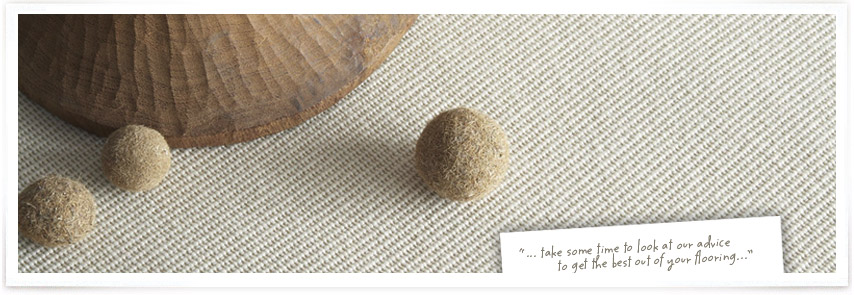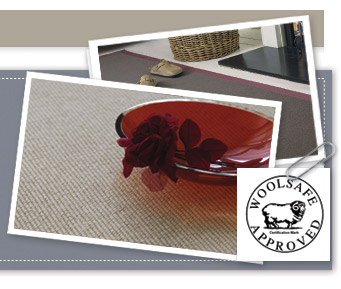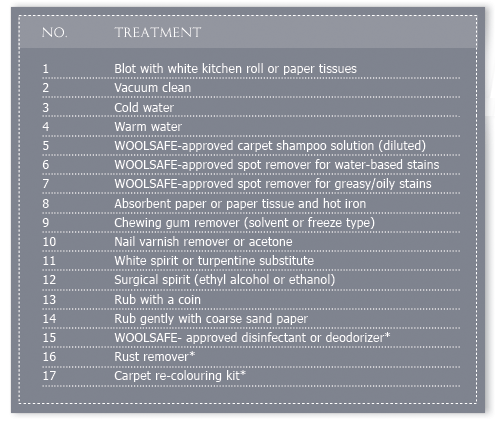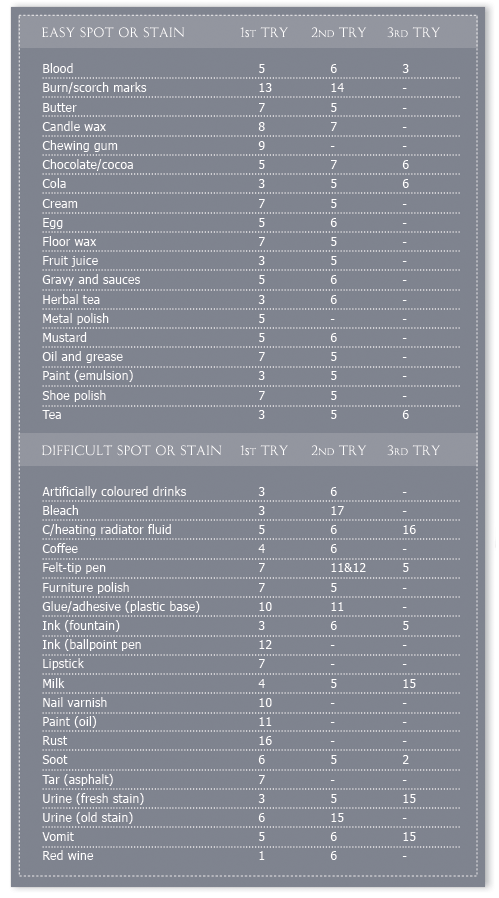


How to prevent stains before they make there mark
When your carpet needs a good clean
General Rules for spot removal
Treatment for spot removal
Treatments used by professional carpet cleaners
Carpet troubleshooter
For further information on WOOLSAFE
When your carpet needs a good clean
General Rules for spot removal
Treatment for spot removal
Treatments used by professional carpet cleaners
Carpet troubleshooter
For further information on WOOLSAFE
How to prevent stains before they make there mark
Regular Maintenance
Regular cleaning will extend the life of a carpet and maintain its appearance. Vacuum clean regularly and thoroughly, which removes gritty dirt that can damage the fibres.
Deal with spillages as soon as possible, preferably the moment they occur.
Entrance or walk-off mats
The use of entrance mats at all outside entrances to the house is highly recommended, as they will significantly reduce the rate at which the carpet will soil. They should be of adequate size to allow street dirt to be removed from shoe soles and must be cleaned regularly themselves.
Protective treatments
Many carpets come with a protective fibre treatment to reduce problems with staining and soiling. These treatments, while effective in many ways, are not bullet-proof and will eventually wear off. Quick response to spills and regular cleaning is still required.
Carpets that have no protector applied by the manufacturer can be treated after installation on the floor by a WOOLSAFE accredited carpet cleaning company. (To find the nearest WOOLSAFE Certified Operator in your area visit: www.woolsafe.org and go to the PRIVATE HOUSEHOLDER section.)
Beware of products claiming to be safe on all fibres, including wool. It might be true, but if it does not have the WOOLSAFE mark, it is not endorsed by most carpet manufacturers!
When your carpet needs a good clean
Periodic Cleaning
When the carpet or rug reaches a stage where it could do with a really good clean, you can either do the job yourself, or you can call in a specialist carpet cleaning company.
If you are considering cleaning the carpet or rug yourself make sure to use only WOOLSAFE- approved products. Look for the mark on the bottle or package:
WOOLSAFE-approved carpet care products have been independently and scientifically tested and are safe and effective for cleaning and maintaining all types of carpets and rugs.
Treatment for removal
Use these following tables guides to try and treat your stain.
Key code to your treatment:


*Treatment used by professional carpet cleaners
Carpet troubleshooter
Colour Matching
Carpets are produced in batches - known as creels - and usually each batch produces between 500m2 - 3000m2 in a single width, depending on the creel size. Whilst the recipe used by the dyer remains constant, and is followed to the letter, in each separate production the colour reproduction will vary from batch to batch. However production is matched back to the original or master sample to ensure that the colour remains ‘within a commercial tolerance’. This process if not an exact science and a commercial tolerance is subjective but nevertheless is usually the professional judgement of the head dyer based on his/her experience. A greater level of tolerance is required on blended colours (Heathers etc). To ensure perfect colour matching it is advisable that a single width be used in any installation requiring exact colour matching. N.B. Carpets which are laid with the pile travelling in different directions, even though they be from the same batch will appear not to match. For further information please check with the manufacturers recommendations.
Samples
The samples held by individual retailers may not be from the same batch as current production and therefore should be used as a guide and not an exact colour match.
Shedding
All cut pile carpets will lose short fibre, which is created during production when spun yarn is cut for tuft formation. These fibres fall onto the surface of the pile and appear as ‘fluff’. The effect varies with yarn type and may be removed without detrimental effect upon the carpet by vacuum cleaning. This excess fibre is only a small fraction of the total fibre contained in the carpet.
Pulled loops
Pulled loops occur only in looped pile carpet where one or more loops in the continuous pile is pulled through the primary backing of the carpet. This is usually due to some local condition, possibly some sharp object which has caught in a loop in situ and has resulted in a pull. Pulled loops are easily dealt with by trimming the offending end level with the rest of the pile. They should not be left as this could result in further loops being pulled and developing into a ladder.
Sprouting
Occasionally an odd tuft or two can work its way to the surface and stand proud of the rest of the pile. This is probably due to one end of the tuft being longer than the other i.e. J shaped tuft instead of V shaped. Remedial action merely requires that the offending tufts be scissor trimmed level with the rest of the pile. They should never be pulled out.
Shading
Shading occurs because the pile of the carpet has become crushed, flattened or brushed in a different direction to the natural lie of the pile whilst in situ. This causes light reflection at differing angles resulting in the creation of light and dark patches on the carpet. This will occur on all pile fabrics but can be more noticeable on plainer carpets because the shadows created by pile pressure will not be disguised by a heavy pattern or design.
Static
Carpets do not produce static but like other household fabrics and objects have the capacity to store it. Static is caused by the build up of static electricity upon personnel in a dry environment and is discharged when a person makes contact with an object which can conduct electricity (i.e. door handle or filing cabinets, etc). The static charges will vary in intensity depending upon the individual, air humidity and the contact materials. Static is more usually associated with synthetic materials as they do not retain moisture very well but it can and does occur with wool in very dry room conditions. Preventative measures include the introduction of moisture into the room or in situ carpet treatment.
Fading on wool
Carpets made from wool can and do fade in use. The degree of fade can vary depending on the colour chosen and the local conditions to which the carpet is subjected. Fading can be caused by exposure to ultra violet light which is found in daylight, but is accelerated when sunlight shines directly onto the carpet. This has the effect of lightening or “Bleaching” the colour just as exposure to sunlight will lighten human hair. Wool is after all animal hair. Protection should be given to carpets exposed to such conditions just as you would protect other furniture or fabrics. A complaint on fading would be considered justified if it failed to meet the required shade standard when tested to the British Standard BS1006 (1990).
Pile Reversal
Like shading, this occurs when the pile or nap of the carpet changes direction and thus reflects light at different angles showing the effects of shading which can become permanent. It is also described as ‘watermarking’. This can happen to every carpet construction be it Axminster, Wilton, Tufted, Hand Woven, Persian, Chinese, Indian or even Coir Matting. Like shading it can be more apparent on plain carpet because heavy patterns can disguise the effects. It can occur quite quickly after installation. A tremendous amount of research has been carried out over many years by many institutes to determine the cause of this phenomenon but none of it has proved conclusive. There is no commonly known manufacturing process which can cause or cure this phenomenon and therefore it is not a manufacturing fault. For further information please check with individual manufacturers recommendations.
Indentations
When a carpet is subjected to a heavy point load, such as under the legs of furniture, it is unreasonable to expect the carpet not to indent. Usually, the longer the load is in place, the longer will be the time for the pile to recover. In the case of very heavy loads in place for a considerable time, the recovery time can be very considerable. It must be remembered that it is not only the pile of the carpet that becomes indented. The underlay will also indent and the backing of the carpet may also distort into the indentation in the underlay. Some underlay’s will recover well and some less well depending upon their composition, thickness, density etc. The use of cups below furniture legs can spread the load and the net result is a larger area of less deeply indented carpet. The ability of a carpet to recover from a heavy static load can be measured in the laboratory, using the test method described in BS 4939 and many manufacturers will have data on this aspect of carpet performance. In this test the carpet is loaded for 24 hours and the degree of recovery is measured after 1 hour and 24 hours. Since there are so many different underlay’s however, it is very rare for the recovery from a heavy static load to be evaluated on carpet and underlay. Often normal maintenance (vacuum cleaning with a rotating brush machine) will speed up recovery but in the case of serious indentations the use of an iron and damp cloth or a steam iron together with a blunt darning needle to carefully tease up the pile can be beneficial. Care must be take not to over wet the carpet, of course.
Flattening
Flattening will occur as a result of traffic which eventually flattens the pile particularly in the main areas of use. All pile fabrics will flatten to greater or lesser degree dependant on the amount of traffic to which it is subjected and the construction (tuft density/pile fibre/height/weight) of the product concerned.
Soiling
Soiling is usually the result of some local condition to which the carpet has been subjected to, or maintenance, or lack of maintenance programme. There is nothing we as manufacturers can do to prevent soiling in use. There are several types of soiling which are quite common: Spillages - Liquids such as soft drinks, cordials or any drink which contains sugar, particularly hot drinks, is likely to leave a stain. In such instances, professional help should be sought. Shampoo - if incorrectly applied, can leave sticky soap residues in the fibres which can result in the soiling reappearing quite rapidly. Dust - which is carried on draughts can soil carpets in various ways, apart from the obvious soiled edges, at gaping skirting boards for instance, dark lines appearing on surface might suggest airborne dust vacuum drawn through poorly fitted floorboards. Sometimes the shape of floorboards can be seen quite clearly. Air borne dust sometimes shows itself as spots on the carpet, this is due to the air carried on a draught under the carpet escaping through minute holes both in the underlay and the carpet, leaving dust deposited on the pile much like a filter action. In such installations, the use of a lining paper is essential as a preventative measure. It is the responsibility of the retailer to advise the consumer when the carpet is measured of any poorly fitting doors, skirtings, or floorboards and the consumers responsibility to ensure any remedial work to seal draughts, is carried out before the carpet is fitted, if a resulting complaint is to be avoided.



